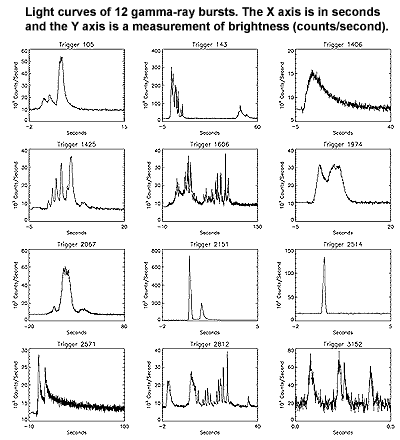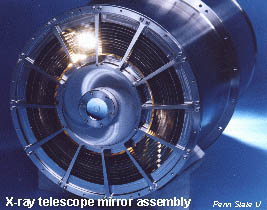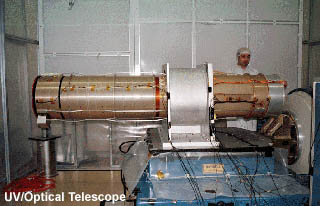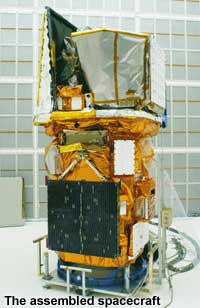AstroCappella: Swift Song
Super-bright Explosions!
Gamma-ray bursts are the most powerful explosions in the Universe, and also the least well understood. We detect these bursts at a rate of about one per day, spread randomly across the gamma-ray sky. A gamma-ray burst is as powerful as a billion trillion suns, and for a few brief moments it outshines anything else in the Universe. The cause of such super-bright explosions is one of the greatest astronomical mysteries in modern times.We now have a dedicated satellite to study these bursts and their afterglows. NASA and its university partners have just finished building the Swift Gamma-Ray Burst Explorer, whose primary goal is to address the gamma-ray burst mystery. Swift will localize and study hundreds of bursts a year during its lifetime. It was launched into orbit in November 2004. When science data start coming down in the next few months, it will revolutionize our view of the gamma-ray sky.
 |
 |
A Space-Age Mystery
Gamma rays are the most energetic form of electromagnetic radiation, much more energetic than radio waves, microwaves, infrared, the visible light we see with our eyes, ultraviolet, or even X-ray radiation. (You can find out more about the electromagnetic spectrum in the background materials for "High Energy Groove" and "Cosmic Radio Show"!) Gamma rays have wavelengths of 10-12 meters -- about the size of an atomic nucleus -- and a gamma ray has about one million times as much energy as a photon of visible light. X-ray and gamma-ray emission mark the most powerful and dramatic upheavals in the Universe.As most gamma rays are absorbed in the Earth's atmosphere, gamma-ray astronomy did not get going until the 20th century, when balloons and rockets could get above most or all of the atmosphere to measure these energetic photons. Gamma rays are also hard to detect because they pass right through conventional mirrors.
The first gamma-ray burst was seen in 1967, by detectors on board a satellite intended to look for violations of the Nuclear Test Ban Treaty. However, the data showed a burst of emission not from the Earth, but from a region of outer space! The largest and best gamma-ray satellite to date was the Compton Gamma Ray Observatory (1991-2000). One of its four instruments, the Burst And Transient Source Experiment, or BATSE, detected over 2,700 gamma-ray bursts. BATSE showed us that these bursts can come from any direction in the sky and last from a few milliseconds to a few minutes.
These events are among the most puzzling and intriguing astronomical phenomena found in modern times. Only recently have we begun to understand in some small part the true nature of these most energetic and relativistic events since the Big Bang. The time has come for us to discover their nature, and to use them as a unique probe into our Universe and into the physics of matter and energy. Swift will detect much fainter bursts, accurately locate the emission, and examine their afterglows at X-ray, ultraviolet and optical energies very soon after the initial detection.

A Beacon Shining Clear Across the Universe
What causes gamma-ray bursts? How can so much energy be created in such a short amount of time?Only in the last few decades have we begun to make headway in understanding these strange sources. Here are a few key events in the History of Gamma-Ray Bursts:
1992: Charles Meegan and collaborators use data from the BATSE instrument on the Compton Gamma Ray Observatory to show that gamma-ray bursts are isotropic -- they have no "preferred direction".

1997: The first X-ray afterglow of a gamma-ray burst is discovered by scientists using data from the Italian-Dutch BeppoSAX satellite. A 25th magnitude dwarf galaxy is found at the site of the afterglow for the gamma-ray burst, named GRB970228.

1997: The first optical afterglow is detected from the same burst, by Jan van Paradijs and his co-workers.
1997-2000: The BeppoSAX and RXTE satellites provide afterglow measurements for over a dozen gamma-ray bursts. Astronomers find that these afterglows are almost always associated with faint galaxies at high redshifts.
2001: The November 21st GRB showed the telltale signs of a supernova, lending support to the idea that at least some GRBs are produced during the death cries of massive stars.
2003: The brightest afterglow yet detected was from GRB030329, a relatively close GRB which showed several re-brightening episodes, which may indicate that more complex phenomena are occurring near the burst.
2004: Swift launched on November 20. As of April 2018, Swift has observed more than 1300 bursts.
So, we now know that
- The initial fireball of a gamma-ray burst creates a super-relativistic blast wave that creates an afterglow that cascades down from gamma rays through X rays, to optical and radio. (A panchromatic, i.e. multiwavelength, approach is essential for the next phases of discovery!)
- Gamma-ray bursts seem to be associated with "host galaxies", at "cosmological" distances -- meaning that they can be located more than halfway to the edge of the visible Universe, at high redshifts. When we look at objects at such large distances, we are also looking back into the past.
- They are incredibly bright! Such distances mean that the total energy release for a gamma-ray burst is 1051 to 1054 ergs.

Popular models for the origin of the gamma-ray burst blast wave include
- The merger of binary neutron stars;
- The merger of a neutron star with a black hole;
- The collapse of a massive, rapidly spinning star (known as a "hypernova").


Artist conception of orbiting neutron stars and the merging of neutron
stars.

Artist conception of a hypernova (with a cutaway of the disk).
Catching Gamma-Ray Bursts on the Fly
Swift is the first mission to focus on studying these recently-discovered afterglows from gamma-ray bursts. Swift has the capability to determine the origin of these still-mysterious GRBs, and to use them to probe the conditions that existed in the early Universe.Within seconds of detecting a burst, Swift's rapid repointing capability will enable high-precision X-ray and optical positions to be determined and relayed to the ground, for use by a network of dedicated observers at large telescopes. Swift will determine redshifts for most of the bursts that it detects (allowing us to know how far away they are and their absolute brightness), and will also provide detailed light curves for the duration of the afterglow, allowing us to probe the physical environment in which the event took place.
 The Swift gamma-ray burst explorer has a complement of three
co-aligned telescopes, covering energies from optical through to
gamma-ray. The main instrument is the Burst Alert Telescope, or BAT,
which provides the initial gamma-ray burst trigger. The BAT was
designed with two important features: it has a large field of view,
meaning it can observe a large fraction of the sky all at once, and it
contains a coded aperture mask. Coded apertures have many tiny holes,
and by using the shadow pattern cast by the light (in this case,
gamma-ray light) through the holes onto the detector below, scientists
can locate the position in the sky where the burst originates. The
BAT will detect and locate about one gamma ray burst per day, and
relay a 1-4 arcminute position (that's better than 1/15 of a degree of arc)
to the ground within 15 seconds of the
detection. This position will then be used to quickly -- and
automatically -- repoint the spacecraft to bring the burst area into
the narrower focus of the instruments that have been designed
to study the afterglow: the X-ray Telescope (XRT), and the
UltraViolet/Optical Telescope (UVOT).
The Swift gamma-ray burst explorer has a complement of three
co-aligned telescopes, covering energies from optical through to
gamma-ray. The main instrument is the Burst Alert Telescope, or BAT,
which provides the initial gamma-ray burst trigger. The BAT was
designed with two important features: it has a large field of view,
meaning it can observe a large fraction of the sky all at once, and it
contains a coded aperture mask. Coded apertures have many tiny holes,
and by using the shadow pattern cast by the light (in this case,
gamma-ray light) through the holes onto the detector below, scientists
can locate the position in the sky where the burst originates. The
BAT will detect and locate about one gamma ray burst per day, and
relay a 1-4 arcminute position (that's better than 1/15 of a degree of arc)
to the ground within 15 seconds of the
detection. This position will then be used to quickly -- and
automatically -- repoint the spacecraft to bring the burst area into
the narrower focus of the instruments that have been designed
to study the afterglow: the X-ray Telescope (XRT), and the
UltraViolet/Optical Telescope (UVOT).
 The gamma-ray burst itself may only last for a fraction of a second to
a minute, but the afterglow of the explosion can often be seen in
X rays, optical light, and radio light for days and even weeks after
the gamma-ray event. From the X-ray afterglows first discovered by the
BeppoSAX satellite in 1997, scientists could measure the distance to
many bursts and identify the host galaxies in which the bursts took
place. The X-ray Telescope (XRT) on Swift is made mostly of "spare
parts" from X-ray telescopes built for previous European missions. The
XRT will provide a more accurate location for the burst, and also
provide an X-ray spectrum of the afterglow. From the spectrum,
astronomers can figure out the temperature of the material in the
burst environment, and perhaps even identify particular types of atoms
-- elements -- in the region.
The gamma-ray burst itself may only last for a fraction of a second to
a minute, but the afterglow of the explosion can often be seen in
X rays, optical light, and radio light for days and even weeks after
the gamma-ray event. From the X-ray afterglows first discovered by the
BeppoSAX satellite in 1997, scientists could measure the distance to
many bursts and identify the host galaxies in which the bursts took
place. The X-ray Telescope (XRT) on Swift is made mostly of "spare
parts" from X-ray telescopes built for previous European missions. The
XRT will provide a more accurate location for the burst, and also
provide an X-ray spectrum of the afterglow. From the spectrum,
astronomers can figure out the temperature of the material in the
burst environment, and perhaps even identify particular types of atoms
-- elements -- in the region.
The third instrument, the UVOT, makes ultraviolet and optical
measurements of the afterglow. The UVOT itself is a 30-cm telescope
with CCD detectors, and is almost identical to an optical monitor
device currently being flown on the European Space Agency's XMM-Newton
mission. Above the atmosphere and well away from the light pollution
that often plagues observatories on Earth, the UVOT instrument is as
sensitive as a 4-meter telescope would be on Earth.

These two longer-wavelength instruments, the XRT and UVOT, will swiftly produce arc-second (1/3600 of a degree) positions and finding charts for the burst and send them to the ground, and also determine the redshift of the burst source. All data from the Swift spacecraft will be made public immediately, with raw data and quick-look products made available on the Internet within 30 minutes of the burst.
The positions and images from the three instruments will be sent from the spacecraft, via the TDRSS system, to the Gamma-ray burst Coordinates Network (GCN) on Earth. The GCN broadcasts the results to the world via the Internet, setting off beepers in astronomers' pockets and sending Email messages, alerting astronomers to quickly perform additional follow-up observations using other ground-based and space-based observatories. Some robotic telescopes can aim directly at the burst coordinates within seconds, with no humans at all in the loop; for example, in January 1999, the ROTSE automatic telescope caught a minute-long burst only 20 seconds after the burst began.
The next time Swift passes over the Malindi ground station, the more detailed data will be sent to the Swift Data Center, where they will be processed for public access within 30 minutes.
In addition to its study of gamma-ray bursts, the Burst Alert Telescope on Swift will also produce a survey of the entire sky in hard (10-150 keV) X-rays. (This is a similar energy range to what your doctor and dentist use when you get a chest or dental X-ray image taken.) This BAT survey will be a factor of 100 more sensitive than previous surveys, and may detect more than 400 new supermassive black holes.


Who Makes Swift Go?
Swift is an international collaboration, and many teams are involved. The Principal Investigator is Dr. Neil Gehrels at NASA's Goddard Space Flight Center. (He and one of the main co-investigators, Dr. Nick White, the Lab Chief at the Laboratory for High Energy Astrophysics, often argue about who came up with the original idea for Swift -- each insists it was the other!)Mission management is the responsibility of NASA/GSFC. In addition, the Goddard Center is also responsible for the development of the BAT instrument. Pennsylvania State University (PSU) is responsible for the XRT and UVOT instruments' electronics, and will supply the Operations Center, where the satellite will be controlled. Spectrum Astro is providing the spacecraft. Los Alamos National Laboratory in New Mexico will write the BAT instrument flight software. Sonoma State University is leading the Swift mission Education and Public Outreach efforts, in close collaboration with PSU and NASA/GSFC.
Swift is a multi-national collaboration. Leicester University (UK) is responsible for the XRT telescope; MSSL (UK) is providing the UVOT instrument; the Instituto di fisica Cosmica (IFC/CNR, Italy) will provide ground system support; and Brera Observatory (Italy) produces the X-ray mirrors. Italy is also providing ground station support through its facility at Malindi. Scientists at a variety of other institutions worldwide are involved in the Swift Science Team.
The three instruments were integrated into the Swift satellite starting in late 2002. After that, Swift was tested during much of 2004 and then the satellite was driven to Florida to be loaded onto its launch vehicle, a Delta 2 rocket. Liftoff occurred from Cape Canaveral on November 20, 2004. Swift settled into an orbit at an altitude of 600 km and an inclination of 20.6 degrees. It orbits the Earth once every 96 minutes. The mission has a nominal on-orbit lifetime of 3 years.
Questions, Questions
- Where, and what, are the progenitors of GRBs?
- Are there different classes of gamma-ray burst, with different physical processes at work in each?
- How does the immense blast-wave from these cataclysmic events evolve, and affect the local environment near the burst?
- What can gamma-ray bursts tell us about the early Universe?
Although gamma-ray bursts are far away, the answers to these questions may not be. To solve these mysteries, study the physics of extreme environments, and better understand our Universe, NASA is flying the Swift mission. Stay tuned!
Credits: Some of the text for this article was adapted from materials written for Swift public outreach by Lynn Cominsky, Sonoma State University & NASA's Swift Mission, California, and by Christopher Wanjek, NASA/GSFC, Maryland. Additional materials were adapted from the Swift Phase A Study and other associated mission documents. "The Swift Song" was commissioned by Swift PI Neil Gehrels, NASA/GSFC, Maryland, to be the theme song for the mission. The Chromatics thank the Swift Team for their support!
